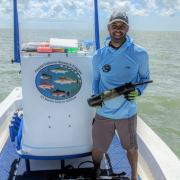
Estuaries may appear to be quiet sanctuaries perfect for a meditative retreat or an escape from the hum of the city, but they are anything but silent. The Mission-Aransas Reserve, along with partners from North Inlet-Winyah Bay and Rookery Bay Reserves and researchers from The University of Texas at Austin, the University of South Carolina Beaufort, and the Florida International University are monitoring ecosystem change by studying the sounds within the estuary seascape. With support from the National Estuarine Research Reserve System’s Science Collaborative program, the partners will be developing a new acoustic monitoring program that can be integrated into existing long-term monitoring, management, and education efforts throughout the region. This comprehensive effort will provide a regional level understanding of the resilience of estuarine ecosystems to hurricanes, oil spills, climate change, eutrophication, coastal development, and other local stressors.
This area of study is called soundscape ecology, and it includes measuring and monitoring all the sounds produced within a particular area, including those made by wildlife, humans (and our contraptions), and the physical environment such as rain hitting the ground or trees groaning in the wind. These sounds generate unique patterns across spatial and temporal scales, providing scientists an insight into the biodiversity and health of the surrounding ecosystem. Scientists use sounds to measure many aspects of biodiversity, such as species richness and community composition. They also study how these sounds interact.
Soundscapes occur in terrestrial and aquatic environments, each telling the story of that particular area over a given distance and duration. Sounds vary by season, time of day, and within the vertical and horizontal environment - think seafloor versus water column. Understanding the changes within a soundscape is critical to recognizing the changes within an ecosystem.
There are several strategies scientists use to “listen in” on the surrounding ecosystem. In aquatic systems, the dual use of passive acoustics and active acoustics capture both the range of biological complexity, as well as the patterns of organism abundance, distribution and behavior across time and space. Passive acoustics is simply the listening of sounds, such as using an underwater microphone (hydrophone) to hear fish chorusing during a spawning event. Active acoustics is when you send a pulse of sound through the water and listen to its echo, such as using sonar to detect the location and relative size of a fish or school of fish swimming through the water.
In addition to aquatic monitoring, the Mission-Aransas Reserve has been participating in a terrestrial-based soundscape project. This pilot project supported the installation of sound boxes, passive recording devices, in a handful of reserves across the country. The goal of the project is to establish both baseline soundscape data as well as a procedural framework that could inform future soundscape monitoring projects within the NERR System.
The next time you visit an estuary, or any environment for that matter, be sure to listen in to the diverse sounds that compose its soundscape.
About the author: Kristin Evans is the Education Coordinator for the Mission-Aransas Reserve overseeing education and outreach programs for K12 and public audiences, including our two public interpretive centers the Bay Education Center in Rockport and the Patton Marine Science Center in Port Aransas.
